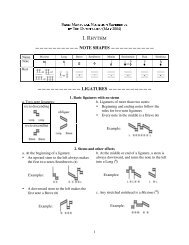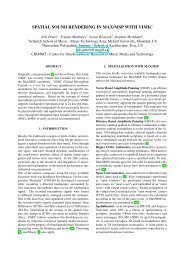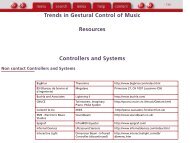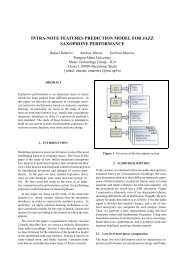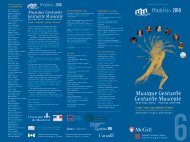Meaning in Musical Gesture
Meaning in Musical Gesture
Meaning in Musical Gesture
Create successful ePaper yourself
Turn your PDF publications into a flip-book with our unique Google optimized e-Paper software.
This projection towards the listener is re<strong>in</strong>forced by the processes of reproduction that imposed new<br />
models of reception. When the phonograph was <strong>in</strong>vented about one hundred years ago, music reception<br />
was based on the listen<strong>in</strong>g model of that time, that is, the listen<strong>in</strong>g of a live performance. The ma<strong>in</strong> goal of<br />
those record<strong>in</strong>g systems was guided by the term fidelity, which <strong>in</strong> that case would mean that the better a<br />
record<strong>in</strong>g could reproduce the sound qualities of a live performance the better it would be considered<br />
(Thompson 1995). But what we experience today is a different situation. The live performance cannot be a<br />
listen<strong>in</strong>g model anymore s<strong>in</strong>ce, for most of us, listen<strong>in</strong>g to music means listen<strong>in</strong>g to the music reproduced<br />
by a device such as radio, or CD. Gradually, this new context based on record<strong>in</strong>g and reproduction becomes<br />
the model for music reception and music production. The term fidelity, which presupposes some relation of<br />
similarity, is still <strong>in</strong> use by phonographic and audio <strong>in</strong>dustries, but its mean<strong>in</strong>g became reflexive and<br />
<strong>in</strong>appropriate: the fidelity of a recorded sound is not based upon the orig<strong>in</strong>al sound itself but it is<br />
established as a function of the available record<strong>in</strong>g technology. This leads to a paradoxical situation <strong>in</strong><br />
which more and more musicians try to reproduce <strong>in</strong> their live performances the same sound qualities of<br />
their records, specially <strong>in</strong> pop music. In a stimulat<strong>in</strong>g essay, John Mowitt observes that:<br />
"If record<strong>in</strong>g organizes the experience of reception by condition<strong>in</strong>g its present scale and establish<strong>in</strong>g<br />
its qualitative norms for musicians and listeners alike, then the conditions of reception<br />
actually precede the moment of production. [T]he social analysis of musical experience has to<br />
take account of the radical priority of reception." (Mowitt 1987: 176-77)<br />
<strong>Gesture</strong><br />
The second alteration is related to musical gesture. Although music has always been strictly related to<br />
gesture, only <strong>in</strong> the past few decades this issue has deserved some attention by musicologists. This concern<br />
seems to emerge when it became possible to record and to reproduce music and the role of performance<br />
was replaced by a listen<strong>in</strong>g situation mediated by new technologies such as the radio, magnetic tapes, or<br />
CDs. As Roland Barthes says, there is one music one plays and one music one listens to. The music one<br />
plays is<br />
"a muscular music, <strong>in</strong> which the part taken by the sense of hear<strong>in</strong>g is one only of ratification as<br />
though the body were hear<strong>in</strong>g [...] a music which is not played 'by heart': seated at the keyboard<br />
or the music stand, the body controls, conducts, co-ord<strong>in</strong>ates, hav<strong>in</strong>g itself to transcribe what it<br />
reads, mak<strong>in</strong>g sound and mean<strong>in</strong>g, the body as an <strong>in</strong>scriber and not just transmitter, simple<br />
receiver." (Barthes, 1977: 149)<br />
This musica practica has been replaced by a passive and receptive music. Electronic technology br<strong>in</strong>gs<br />
this situation a step further by elim<strong>in</strong>at<strong>in</strong>g the traditional role of the performer from the cha<strong>in</strong> of music<br />
production. However, it seems that at the same time that electronic technology stresses this shift from the<br />
idea of a music to be done to the idea of a music to be listened to (Chanan, 1994; Mowitt, 1987), it also<br />
po<strong>in</strong>ts to the conflict between the physicality traditionally <strong>in</strong>volved <strong>in</strong> music production and the absence of<br />
concrete objects <strong>in</strong> the virtual environment of today's digital studios: "It is precisely this physical absence<br />
that is naturally compensated for <strong>in</strong> music by re<strong>in</strong>troduc<strong>in</strong>g a concern for body, gesture and space" (Chabot,<br />
1990: 15).<br />
Indeed, the <strong>in</strong>terest <strong>in</strong> gesture's related subjects has been developed by different fields related to human<br />
communication and cognition due to different reasons: the concern with the body <strong>in</strong> cognitive sciences as<br />
an agent of knowledge (Johnson, 1987; M<strong>in</strong>sky, 1986; Varela, Thompson, & Rosch, 1991); the grow<strong>in</strong>g<br />
<strong>in</strong>terest <strong>in</strong> non-verbal forms of communication <strong>in</strong> semiotic and psychology studies (Kendon, 1981; Nöth,<br />
1990; Poyatos, 1983); the development of studies <strong>in</strong> sign languages of the deaf, especially American Sign<br />
Language (Kendon, 1981: 31); the studies <strong>in</strong> Human-Computer Interaction promoted by the large<br />
expansion of digital technology that brought the possibility of simulat<strong>in</strong>g physical phenomena <strong>in</strong> "virtual"<br />
environments (Barfield & Furners III, 1995; Carr & England, 1995; Laurel, 1990).<br />
<strong>Gesture</strong> is taken here <strong>in</strong> a broad sense. It does not mean only movement, but a movement that can<br />
express someth<strong>in</strong>g. Therefore, it is a movement that embodies a special mean<strong>in</strong>g. It is more than a change<br />
<strong>in</strong> space, or a body action, or a mechanic activity: gesture is an expressive movement that becomes actual<br />
through temporal and spatial changes. Actions such as turn<strong>in</strong>g knobs or push<strong>in</strong>g levers, are current <strong>in</strong> the<br />
use of today's technology, but they cannot be considered gestures. Also, to type a few words <strong>in</strong> a computer's<br />
keyboard has noth<strong>in</strong>g to do with gesture s<strong>in</strong>ce the movement of press<strong>in</strong>g each key does not convey any<br />
special mean<strong>in</strong>g. It does not matter who or what performed that action, neither <strong>in</strong> which way it was<br />
performed: the result is always the same. However, the situation is completely different when a musician<br />
plays someth<strong>in</strong>g on a piano keyboard: the result, that is, the musical performance, depends <strong>in</strong> many<br />
different ways on the player's gesture. Press<strong>in</strong>g a key or slid<strong>in</strong>g a bow dur<strong>in</strong>g a performance are movements<br />
that hold a mean<strong>in</strong>g <strong>in</strong> themselves: they establish how a sound will be produced, they determ<strong>in</strong>e some<br />
Repr<strong>in</strong>t from : Trends <strong>in</strong> Gestural Control of Music, M.M. Wanderley and M. Battier, eds.<br />
© 2000, Ircam Centre Pompidou 260




